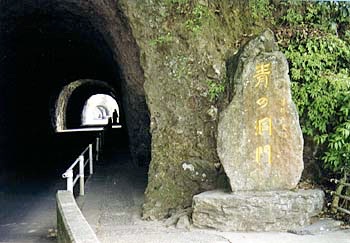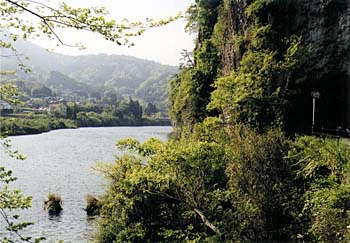

































From Usa, you can head inland (along several possible routes) to the Yabakei area. Almost completely ignored on the normal non-Japanese tourist itineraries, this area has a number of unusual things to see, including this one: Ao no Domon, a long series of tunnels supposedly carved through solid rock by an ex-samurai turned penitant Buddhist priest. It's quite an amazing story; he finished them after 30 years, at age 77! The entrance to one of the tunnels actually has a small alter and a bust of said samurai-priest with hammer raised.
Literary notes: Ao no Domon was supposedly the setting for one of Akutagawa's novellas; more recently, most Japanese know it from the novel Onshu no Kanata ni (the serene realm beyond love and hate) by Kikuchi Kan, and the story seems to have inspired the novel The Ronin by William Dale Jennings.
Coming out of the last tunnel, you see another reason to be glad you came: the area is lovely. On my first visit here, I stayed at the local youth hostel, which also turned out to be a ryokan inn (it's not uncommon for hostels to be located in one section of a more pricey inn). To a budget traveler, that usually means much better meals than normal hostel fare. A fellow Japanese traveler told me she thought the same thing when she saw the characters for "ryokan" beside the youth hostel sign: "I will eat very well tonight!" We did, too.

